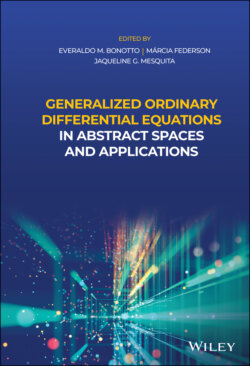Читать книгу Generalized Ordinary Differential Equations in Abstract Spaces and Applications - Группа авторов - Страница 12
1 Preliminaries
ОглавлениеEveraldo M. Bonotto1, Rodolfo Collegari2, Márcia Federson3, Jaqueline G. Mesquita4, and Eduard Toon5
1Departamento de Matemática Aplicada e Estatística, Instituto de Ciências Matemáticas e de Computação (ICMC), Universidade de São Paulo, São Carlos, SP, Brazil
2Faculdade de Matemática, Universidade Federal de Uberlândia, Uberlândia, MG, Brazil
3Departamento de Matemática, Instituto de Ciências Matemáticas e de Computação (ICMC), Universidade de São Paulo, São Carlos, SP, Brazil
4Departamento de Matemática, Instituto de Ciências Exatas, Universidade de Brasília, Brasília, DF, Brazil
5Departamento de Matemática, Instituto de Ciências Exatas, Universidade Federal de Juiz de Fora, Juiz de Fora, MG, Brazil
This preliminary chapter is devoted to two pillars of the theory of generalized ordinary differential equations for which we use the short form “generalized ODEs”. One of these pillars concerns the spaces in which the solutions of a generalized ODE are generally placed. The other pillar concerns the theory of nonabsolute integration, due to Jaroslav Kurzweil and Ralph Henstock, for integrands taking values in Banach spaces. As a matter of fact, such integration theory permeates the entire book. It (the theory of non absolute integration) is within the heartwood of the theory of generalized ODEs, appearing (the same theory of nonabsolute integration) in the integral form of a very special case of nonautonomous generalized ODEs, namely (now we mention the name of the special case of generalized ODEs), measure functional differential equations.
The solutions of a Cauchy problem for a generalized ODE, with right‐hand side in a class of functions introduced by J. Kurzweil in [147–149], usually belong to a certain space of functions of bounded variation (see Lemma 4.9). However, since functions of bounded variation are also regulated functions in the sense described by Jean Dieudonné and, more generally, by the group Nicolas Bourbaki, and because the space of regulated functions is more adequate for dealing with discontinuous functions appearing naturally in Stieltjes‐type integrals, it is important to present a substantial content about this space. Thus, the first section of this chapter describes the main properties of the space of regulated functions with the icing of the cake being a characterization of its relatively compact subsets due to D. Franková.
Regarding functions of bounded variation, which are known to be of bounded semivariation and, hence, of bounded ‐variation, we present, in the second section of this chapter, a coherent overview of functions of bounded ‐variation over bilinear triples. Among the results involving functions of bounded variation, the theorem of Helly (or the Helly's choice principle for Banach space‐valued function) due to C. S. Hönig is a spotlight. On the other hand, functions of bounded semivariation appear, for instance, in the integration by parts formula for Kurzweil and Henstock integrals of Stieltjes‐type.
In the third section of this chapter, we describe the second pillar and main background of the theory of generalized ODEs, namely, the framework of vector‐valued nonabsolute integrals of Kurzweil and Henstock. Here, we call the reader's attention to the fact that we refer to Kurzweil vector integrals as Perron–Stieltjes integrals so that, when a more general definition of the Kurzweil integral is presented in Chapter 1, the reader will not be confused. One of the highlights of the third section is, then, the integration by parts formula for Perron–Stieltjes integrals.
An extra section called “Appendix,” which can be skipped in a first reading of the book, concerns other types of gauge‐based integrals which use the interesting idea of Edward James McShane. The well‐known Bochner–Lebesgue integral comes into the scene and an equivalent definition of it as the limit of Riemannian‐type sums comes up.
